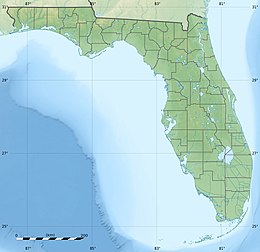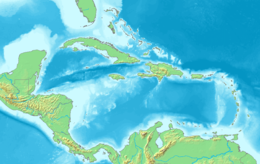| Revision as of 09:10, 7 September 2017 editNorthamerica1000 (talk | contribs)Autopatrolled, Administrators708,032 edits +1 reference. - {{unreferenced|date=January 2011}}← Previous edit | Latest revision as of 19:13, 22 September 2022 edit undoEpolk (talk | contribs)Autopatrolled, Extended confirmed users26,552 editsNo edit summaryTags: Mobile edit Mobile app edit Android app edit | ||
| (29 intermediate revisions by 14 users not shown) | |||
| Line 1: | Line 1: | ||
| {{Short description|Island in the lower Florida Keys, United States}} | |||
| '''Scout Key''' is an ] in the lower ]. It was previously known as '''West Summerland Key''' until 2010.<ref>{{cite book | last=Petuch | first=E.J. | last2=Myers | first2=R.F. | title=Molluscan Communities of the Florida Keys and Adjacent Areas: Their Ecology and Biodiversity | publisher=CRC Press | year=2014 | isbn=978-1-4822-4919-4 | url=http://books.google.com/books?id=f5LSBQAAQBAJ&pg=PA43 | access-date=September 7, 2017 | page=43}}</ref> | |||
| {{Infobox islands | |||
| | name = Scout Key | |||
| | native_name = | |||
| | native_name_link = | |||
| | native_name_lang = | |||
| | sobriquet = <!-- or |nickname= --> | |||
| | image_name = Aerial photographs of Florida MM00034361x (7369661790).jpg | |||
| | image_size = | |||
| | image_caption = Camp Sawyer on Scout Key in 1987 | |||
| | image_alt = | |||
| | image_map = | |||
| | map_alt = | |||
| | map_size = | |||
| | map_caption = | |||
| | pushpin_map = Florida#Caribbean | |||
| | pushpin_label = | |||
| | pushpin_label_position = left | |||
| | pushpin_map_alt = | |||
| | pushpin_relief = 1 | |||
| | pushpin_map_caption = Scout Key | |||
| | coordinates = {{Coord|24.649855|-81.310887|display=it}} | |||
| | etymology = | |||
| | location = ] | |||
| | grid_reference = <!-- UK only --> | |||
| | archipelago = ] | |||
| | waterbody = ] | |||
| | total_islands = | |||
| | major_islands = | |||
| | area_km2 = | |||
| | area_footnotes = | |||
| | rank = | |||
| | length_km = | |||
| | length_footnotes = | |||
| | width_km = | |||
| | width_footnotes = | |||
| | coastline_km = | |||
| | coastline_footnotes = | |||
| | elevation_ft = | |||
| | elevation_footnotes = | |||
| | highest_mount = | |||
| | country = {{USA}} | |||
| | country_admin_divisions_title = State | |||
| | country_admin_divisions = ] | |||
| | country_admin_divisions_title_1 = County | |||
| | country_admin_divisions_1 = ] | |||
| | country_admin_divisions_title_2 = | |||
| | country_admin_divisions_2 = | |||
| | country_capital_type = | |||
| | country_capital = | |||
| | country_largest_city_type = | |||
| | country_largest_city = | |||
| | country_capital_and_largest_city = | |||
| | country_largest_city_population = | |||
| | country_leader_title = | |||
| | country_leader_name = | |||
| | country_area_km2 = | |||
| | demonym = | |||
| | population = | |||
| | population_as_of = | |||
| | population_footnotes = | |||
| | population_rank = | |||
| | population_rank_max = | |||
| | density_km2 = | |||
| | density_rank = | |||
| | density_footnotes = | |||
| | languages = | |||
| | ethnic_groups = | |||
| | timezone1 = | |||
| | utc_offset1 = | |||
| | timezone1_DST = | |||
| | utc_offset1_DST = | |||
| | website = | |||
| | additional_info = | |||
| | footnotes = | |||
| }} | |||
| '''Scout Key''' is an ] in the lower ]. It was previously known as '''West Summerland Key''' until 2010.<ref>{{cite book | last1=Petuch | first1=E.J. | last2=Myers | first2=R.F. | title=Molluscan Communities of the Florida Keys and Adjacent Areas: Their Ecology and Biodiversity | publisher=CRC Press | year=2014 | isbn=978-1-4822-4919-4 | url=https://books.google.com/books?id=f5LSBQAAQBAJ&pg=PA43 | access-date=September 7, 2017 | page=43}}</ref> ] (the ]) crosses the key at approximately ]s 34–35, between ] and ]. | |||
| ==Etymology== | |||
| The Key was renamed to reflect the two adjoining ] on it, ] Camp Sawyer and ] Camp Wesumkee. ] is the site of the ], an annual gathering of amateur ]s. The name change also removed some confusion about its location – despite its name, the formerly-named West Summerland Key is actually about 10 miles ''east'' of ]. | |||
| ] | |||
| The Key was renamed to reflect the two adjoining ] on it, Boy Scout ] and Girl Scout ]. The name change also removed some confusion about its location – despite its name, the formerly-named West Summerland Key is actually about 10 miles ''east'' of ]. | |||
| ] (the ]) crosses the key at approximately ]s 34—35, between ] and ]. | |||
| ==Geography== | |||
| Originally, there were three keys at this location. They were connected by ]s at the time the ] was built. The keys were West Summerland Key (westernmost), Middle Summerland Key (center), and no name is known for the easternmost key. West Summerland retained its name, but the other two are known simply as the ]; named for the ]age located between this key and ]. Interesting features of this key include ]s, and storage buildings still standing from the ] ] ] era. | Originally, there were three keys at this location. They were connected by ]s at the time the ] was built. The keys were West Summerland Key (westernmost), Middle Summerland Key (center), and no name is known for the easternmost key. West Summerland retained its name, but the other two are known simply as the ]; named for the ]age located between this key and ]. Interesting features of this key include ]s, and storage buildings still standing from the ] ] ] era. | ||
| ==Environment== | |||
| Its ] has suffered recent ] damage. The swim platform at Camp Sawyer which was rebuilt after a 2004 storm became, in turn, ] ] in 2005. The ]s came in from the east and eliminated many more trees on the Camp Wesumkee side of the Key than at Camp Sawyer, which still had many fifty-year-old ] trees taken out. | |||
| In 2017, Category 4 ] destroyed much of the fragile mangroves and dunes on the key, reshaping the Atlantic shoreline. A few buildings were crushed and other damaged in both Scout camps. The swimming platform at the Sawyer camp had to be rebuilt yet again after the most recent rebuilds in 2004 and 2005.<ref></ref><ref></ref> | |||
| ==Attractions== | |||
| ] is the site of the ],<ref>{{cite web| url =http://www.scas.org/home/winterstarparty |title = Winter Star Party | publisher = Southern Cross Astronomical Society}}</ref> an annual gathering of amateur ]s. | |||
| ] | |||
| The eastern end of the key has a small parking area on the Atlantic that allows access to the old ], which is a popular photography spot among tourists and locals also known as "Broken Bridge".<ref>{{Coord | 24.6537485 | -81.3111987 | dim:30_region:US-FL_type:landmark |display=inline |name=location of Broken Bridge}}</ref> | |||
| ==References== | ==References== | ||
| {{ |
{{Reflist}} | ||
| ==Further reading== | |||
| * {{cite book | last=Deyrup | first=M. | title=Ants of Florida: Identification and Natural History | publisher=CRC Press | year=2016 | isbn=978-1-315-35101-8 | url=https://books.google.com/books?id=5SuLDQAAQBAJ&pg=PP130 | access-date=September 7, 2017 | page=130}} | |||
| {{Florida Keys}} | {{Florida Keys}} | ||
| {{Coord|24.649855|-81.310887|display=title}} | |||
| {{authority control}} | |||
| ] | ] | ||
Latest revision as of 19:13, 22 September 2022
Island in the lower Florida Keys, United States Camp Sawyer on Scout Key in 1987 Camp Sawyer on Scout Key in 1987 | |
  | |
| Geography | |
|---|---|
| Location | Gulf of Mexico |
| Coordinates | 24°38′59″N 81°18′39″W / 24.649855°N 81.310887°W / 24.649855; -81.310887 |
| Archipelago | Florida Keys |
| Adjacent to | Florida Straits |
| Administration | |
| State | Florida |
| County | Monroe |
Scout Key is an island in the lower Florida Keys. It was previously known as West Summerland Key until 2010. U.S. 1 (the Overseas Highway) crosses the key at approximately mile markers 34–35, between Spanish Harbor Key and Big Pine Key.
Etymology

The Key was renamed to reflect the two adjoining scout camps on it, Boy Scout Camp Sawyer and Girl Scout Camp Wesumkee. The name change also removed some confusion about its location – despite its name, the formerly-named West Summerland Key is actually about 10 miles east of Summerland Key.
Geography
Originally, there were three keys at this location. They were connected by fills at the time the Overseas Railroad was built. The keys were West Summerland Key (westernmost), Middle Summerland Key (center), and no name is known for the easternmost key. West Summerland retained its name, but the other two are known simply as the Spanish Harbor Keys; named for the anchorage located between this key and Big Pine Key. Interesting features of this key include indian mounds, and storage buildings still standing from the Flagler railway construction era.
Environment
In 2017, Category 4 Hurricane Irma destroyed much of the fragile mangroves and dunes on the key, reshaping the Atlantic shoreline. A few buildings were crushed and other damaged in both Scout camps. The swimming platform at the Sawyer camp had to be rebuilt yet again after the most recent rebuilds in 2004 and 2005.
Attractions
Camp Wesumkee is the site of the Winter Star Party, an annual gathering of amateur astronomers.

The eastern end of the key has a small parking area on the Atlantic that allows access to the old Bahia Honda Rail Bridge, which is a popular photography spot among tourists and locals also known as "Broken Bridge".
References
- Petuch, E.J.; Myers, R.F. (2014). Molluscan Communities of the Florida Keys and Adjacent Areas: Their Ecology and Biodiversity. CRC Press. p. 43. ISBN 978-1-4822-4919-4. Retrieved September 7, 2017.
- in Miami Herald
- in Girl Scouts FL
- "Winter Star Party". Southern Cross Astronomical Society.
- 24°39′13″N 81°18′40″W / 24.6537485°N 81.3111987°W / 24.6537485; -81.3111987 (location of Broken Bridge)
Further reading
- Deyrup, M. (2016). Ants of Florida: Identification and Natural History. CRC Press. p. 130. ISBN 978-1-315-35101-8. Retrieved September 7, 2017.
This Monroe County, Florida location article is a stub. You can help Misplaced Pages by expanding it. |